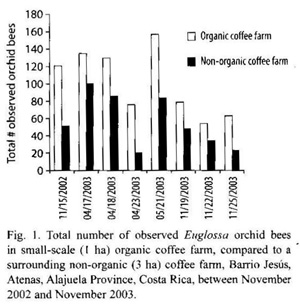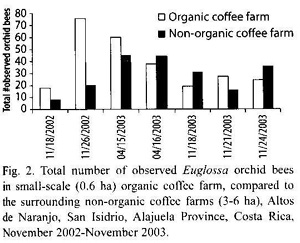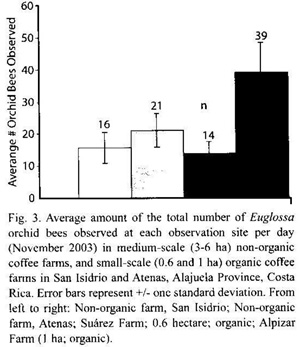Revista de Biología Tropical
versión On-line ISSN 0034-7744versión impresa ISSN 0034-7744
Rev. biol. trop vol.54 no.3 San José sep. 2006
Orchid bees as bio-indicators for organic coffee farms in Costa Rica: Does farm size affect their abundance?
Ingemar Hedström1, Andrew Denzel2 & Gareth Owens3
1 Boston University, College of Arts and Sciences, 725 Commonwealth Avenue, Boston, MA 02215, USA.
Present address: Nairi Foundation, Apdo 150-4021 Orotina, Costa Rica; ingemar.hedstrom@skutan.smf.se
2,3 Centro de Estudios sobre Desarrollo Sostenible (CEDS), Apdo 150-4013, Atenas, Costa Rica.
Received 17-XII-2003. Corrected 27-X-2005. Accepted 15-III-2006.
Abstract: The potential of Euglossini bees, especially Euglossa, as biological indicators of organic vs non-organic coffee farms was studied in Atenas and San Isidro, Alajuela, Costa Rica using 1.8-cineole as lure. Observations were made for three days at each of four farms and complemented with data from a year of observations. Orchid bees were in greater abundance in the organic farms (t-Student test). However, lower abundances suggest that an organic farm may be negatively affected by the proximity of non-organic farms, depending on its size and distance. Orchid bees may be indicators of organic coffee farms. Rev. Biol. Trop. 54 (3): 965-969. Epub 2006 Sept. 29.
Key words: Euglossine, Euglossa, orchid bees, bio-indicator, organic agriculture, Costa Rica.
Beginning in the 1970s, Costa Rica and much of the world began a trend of seeing organic farming as a viable means of production and as a healthier alternative for both humans and the natural environment. Over the past few decades, the severity of the negative effects that modern agriculture has on e.g. water quality, soil health, and biodiversity has become clear. Due to these heavy environmental impacts, there is a need for change in the methods of modern agriculture (Vandermeer 1995).
In order to make the transition to organic agriculture, and insure its success, it is necessary to have a practical method of monitoring organic farms and the "health" of their surrounding environments. The use of biological indicators for monitoring farm health is one realistic possibility due to its low cost and minimal technological requirements.
Orchid bees (Euglossa spp., Euglossini tribe) are proposed here as possible bio-indicators in some neotropical environments such as coffee farm lands since many of their characteristics match the criteria for a good bio-indicator; including wide range of habitat, abundance, and simplicity of monitoring (Noss 1990, Becker et al. 1991).
The object of this study was to investigate orchid bees potential as bio-indicators of organic vs. non-organic coffee farms in Costa Rica. Using data obtained during this study in combination with earlier unpublished data from this long-term study (between November 2002 and November 2003) obtained at the same coffee farms, we tested the hypothesis that the abundance of orchid bees is higher in organic coffee farms than in non-organic coffee farms. Additionally, this study analyzes how farm size might affect these results, based on the hypothesis that the size of an organic farm, when it borders non-organic farms, affects the abundance of orchid bees that visit the farm.
Materials and methods
Suarez farm: On November 18, 21 and 24, 2003, samples were taken from the Finca de Elias Suarez, a shaded, 0.6 ha organic coffee farm (1 100 masl), surrounded by several larger non-organic farms (between 3-6 ha), and located in Altos de Naranjo, San Isidro, Alajuela Province, Costa Rica. From now on the farm will be referred as the Suárez farm, and it is the only organic coffee plantation nearby Atenas.
Alpizar farm: On November 19, 22, and 25, 2003, samples were taken from the Finca de Don Santiago Alpizar, a shaded, 1 hectar organic farm (950-980 masl), located in Barrio Jesus, Atenas, Alajuela Province, Costa Rica. It contains one hectare of organic coffee farm land, and it is bordered on one side by two larger (3-6 hectare) non-organic coffee farms. This farm will be referred as the Alpizar farm from now on, and is the only organic farm in the San Isidro area.
Both the Suárez farm and the Alpizar farm were certified in 2002, and began the transition to organic from non-organic farm land three years earlier. At Suárez farm and Santiago farm, six data sites were used, three within the organic farm and three within the neighboring non-organic farms. At each site a coffee filter was attached to a tree between one and two meters above the ground. Five drops of the attractant 1.8-cineol (eucalyptus oil), were placed on the filter every 15 min in order to attract bees. Data collection began between 8:00 and 8:45 in the morning, depending on the day of observation. The maximum number of bees on the filter at one time was counted during each 15-min interval for 1.5 h. T-tests were conducted to compare the mean values of bees observed in organic and non-organic farms (Ambrose and Ambrose 1987). Histograms were also constructed to compare the abundances of orchid bees, and standard deviations were calculated and included. GIS mapping techniques were used to analyze farm size and orientation.
The eucalyptus oil lure (cineole 1.8, First Essential Oils, USA) contained 80% eucalyptus oil (cineole 1.8) and 20% monoterpenes.
Results
There was a higher abundance of orchid bees in the organic Alpizar farm than in nearby non-organic farm on each day observations were made, considering both earlier and present findings (Fig. 1). In total, the abundance of the bees found in the organic farm was 83% greater than in the non-organic farm (815 organic, 446 non-organic).

T-test results showed that the mean number of bees observed per day was significantly higher in the organic farm when compared with the non-organic farm between November 2002 and November 2003 (t-value 2.658, t-critical 2.145).
Earlier and present data were also compared regarding the organic Suarez farm. During the period between November 2002 and November 2003, depending on the day of observation, orchid bees were found in greater abundance in the organic or non-organic farms (Fig. 2).

In total, the abundance of orchid bees found in the organic Suárez farm was 38% higher than in the nearby non-organic farms (261 organic, 195 non-organic). Despite the overall abundance of orchid bees in the Suarez farm, t-test results failed to show a significant difference between the mean amount of orchid bees observed per day in the organic and non-organic farms between November 2002 and November 2003 (t-value 0.942, t-critical 2.179).
When comparing the results of the Alpizar and Suarez farms obtained during the November 2003 study, the average amount of orchid bees counted at each site per day was significantly greater in the organic Alpizar farm than in the nearby non-organic farms (t-value 5.14, t-critical 2.12). This same average was also greater than the averages in the organic Suárez farm, and its neighboring non-organic farms (t-values 6.768, 7.680 and t-critical 2.12, and ≈ 2.2, respectively). The standard deviation about the mean amount of bees counted at the Suarez farm overlapped the standard deviations of the nearby non-organic farms and the non-organic farms neighboring the Alpizar farm, indicating similar means (Fig. 3).

Discussion
Orchid bees as bio-indicators: Over one year of observation between November 2002 and November 2003 at the Alpizar farm, orchid bees were consistently more abundant in the organic farm than in the nearby non-organic farm (Fig. 1). Because orchid bees are capable of traveling many kilometers in search of fragrances (Dressler 1982, Roubik and Hanson 2004), it is unlikely that this pattern is the result of differences in the locations of the organic and non-organic farms. Since orchid bees are long-distance flyers (more than 1 km), and thus are able to travel to either farm, it appears that the bees chose to avoid the non-organic farm in favor of the organic farm. This choice is likely the result of the presence of chemicals used to reduce pests and weeds in the non-organic farm. In the organic Alpizar farm a plant (Vernonia sp.) was used to deter pests as an alternative to chemicals. In the non-organic farm neighboring the Alpizar farm, however, the herbicide BioQuim Biokil 35.6 SL was observed being sprayed before and during the study. Since the orchid bees have a very acute sense of smell, and it is possible that the odor of this and other chemicals interfered with their search for the eucalyptus oil lure (cineole 1.8) used in this study, and also hinders their seeking of other, natural fragrances. If the presence of chemicals has this detrimental effect on orchid bees, it is likely that other potential pollinator species could be similarly disrupted. This effect could be particularly applicable to many types of fruit farms, which rely on an abundance of pollinators for a good fruit crop. Overall, a higher abundance of orchid bees in the organic coffee farm indicates that a healthier environment may exist in these "organic" environments.
Effect of farm size: Orchid bees showed no significant abundance in the Suárez farm compared to the nearby non-organic farm (Fig. 2). One possible explanation is that the Suarez farm covers too small an area (0.6 ha). Additionally, the Suarez farm is surrounded by non-organic farms. It seems like that the small size of this organic farm, combined with its exposure to the non-organic farms that surround it, cause it to be less successful in maintaining a healthy environment. Chemicals applied to the non-organic areas surrounding the organic farm could be spread by wind or by rain run-off into the organic farm. Because the organic farm is so small, and surrounded on multiple sides by areas in which chemicals are used, it is likely that the chemicals are spread far enough into the organic farm to significantly reduce the amount of farm that is truly chemical free. If this is true, what remains is only a small island of unaffected farm, surrounded by a sea of farms affected by chemicals. Considering this effect, it would be unlikely that orchid bees could distinguish between these organic and non-organic farms. This is supported by the data from this study, which shows that orchid bees were found in similar abundances in the Suarez farm, and both non-organic farms (Fig. 3). This similarity of abundances reveals two important trends. First, both non-organic farms had similar abundances of orchid bees, indicating that higher abundances of orchid bees in the organic Alpizar farm is not a result of a general higher abundance of orchid bees in that area. Second, similar abundances of orchid bees were observed in the Suárez farm and the nearby non-organic farms, indicating that orchid bees were not able to distinguish between the two, theoretically separate, farms.
Orchid bees did seem to distinguish between the Alpizar farm and the nearby non-organic farm based on their significantly higher abundance in the organic farm (Fig. 3). This could be attributed to both the size and orientation of the organic farm in regard to the non-organic farm. First, the Alpizar farm (1 ha) is larger than the Suarez farm (0.6 ha). Additionally, the Alpizar farm borders a non-organic farm on only one side, reducing the amount of edge exposed to the chemicals used in the non-organic farm. Because of these geographical factors, the amount that the non-organic farm affects the organic farm should be significantly lower in the Alpizar farm when compared to the Suarez farms Significantly more bees were observed visiting the Alpizar farm than the Suarez farm, supporting this theory (Fig. 3).
Based on the results so far of this long-term study, the abundance of Euglossa orchid bees appears to be a good indicator of the health of the environment maintained within organic coffee farms. However, in cases where small organic farms are bordered by non-organic farms the abundance of orchid bees may not be as clear of an indicator, possibly due to chemical contamination from bordering farms. Therefore further studies of larger scale organic and non-organic coffee farms may be helpful in making further conclusions about how size affects the health of organic coffee farms.
In addition, species composition of orchid bees sampled in coffee farms was not useful for indication of organic versus non-organic farms in this study. However, the use of other insect species, such as beetles, as bio-indicators might help to compliment orchid bees as indicators of healthy farms. Because orchid bees probably live outside of coffee farm lands, they indicate the health of a farm based on their willingness to enter the farm in search of fragrances. Insects such as some species of beetles might be more restricted to coffee farm land for their entire life period, and so their presence or absence may provide a more direct assessment of the biological diversity maintained within a farm itself. Future use of combinations of bio-indicators, including orchid bees (Euglossa spp.), has great potential to be a comprehensive and accurate method for assessing the health of environments within organic farms.
Acknowledgments
The authors gratefully acknowledge the support provided by the Center for Sustainable Development Studies, the School for Field Studies, SFS, Atenas, Costa Rica. We thank S. Baxley, S. Goodwin, H. Gottgens, L. Bode, M. Hajdun, M. Deltorio, B. Moore, and A. Wallisch, for assistance in the field, and J.G. DeLeo and his team at Lyndon State University, USA, for the GIS maps of the studied coffee farms. We also thank A.K. Borg-Karlsson, Department of Ecological Chemistry, Swedish Royal Technological Institute (KTH), Stockholm, for the chemical test of the eucalyptus oil used in the study.
Resumen
Por un año estudiamos las abejas de la tribu Euglossini (abejas de las orquídeas, especialmente el género Euglossa) en Atenas y San Isidro, Alajuela, Costa Rica, para identificar su potencial como bioindicadoras de fincas orgánicas y fincas "convencionales" de café. Usamos como atrayente aceite de eucalipto (1.8-cineole). Las abejas son más abundantes en las fincas de café orgánico (t-Student). Sin embargo, el relativamente bajo número de abejas en la menor de las dos fincas orgánicas sugiere que el tamaño de una finca orgánica y la proximidad a las fincas convencionales, podrían tener efectos negativos en la orgánica. Estas abejas podrían servir como bioindicadores de fincas orgánicas.
Palabras clave: Euglossinae, Euglossa, abejas de las orquídeas, bioindicadores, agricultura orgánica, Costa Rica.
References
Ambrose, H. & K. Ambrose. 1987. A Handbook of Biological Investigation. Hunter, Raleigh, North Carolina, USA. [ Links ]
Becker, P., J. Moure & F. Peralta. 1991. More About Euglossine Bees in Amazonian Forest Fragments. Biotropica 23: 586-591 [ Links ]
Dressler, R. 1982. Biology of the Orchid Bees (Euglossini). Annu. Rev. Ecol. Syst. 13: 373-394. [ Links ]
Noss, R. 1990. Indicators for Monitoring Biodiversity: A Hierarchical Approach. Cons. Biol. 4: 355-364. [ Links ]
Roubik, D.W. & P.E. Hanson. 2004. Orchid bees of tropical America. Instituto Nacional de Biodiversidad, Santo Domingo, Heredia, Costa Rica. [ Links ]
Vandermeer, J. 1995. The Ecological Basis of Alternative Agriculture. Ann. Rev. Ecol. Syst. 26: 201-224. [ Links ]












 uBio
uBio 

